Sai Movement in Argentina (original) (raw)
You are viewing the old website of the Sathya Sai International Organisation. Use the following link to go to the homepage of the new website.
 |
|
|---|---|
 |
SAI MOVEMENT IN ARGENTINA Heart2Heart team This article first appeared in Heart2Heart, November 2006. The crescent-shaped Iguazú Falls, consisting of 270 cascades along 2.7 kilometers, where every second 176,000 cubic feet of water plunges 230 feet into a craggy abyss; the awe-inspiring Perito Moreno Glacier, a 250 square km mountain of ice, where chunks of ice gracefully fall like a carefully choreographed ballet; Patagonia, a naturalist's dream, home to penguins, guanacos, sea lions, flamingos, and whales; Iguazú National Park, a UNESCO World Heritage Site, with over 2000 known plant species, 400 species of birds, and the ruins of early Jesuit missions; the Andes, the worlds longest mountain chain, with Aconcagua, the highest peak in the Americas; the Pampas, a grand expanse of plains dotted with working ranches and large estates producing grain and cattle and decorated with palatial villas rich in antiques and tradition — the natural beauty of this land encompasses all this and more.   Iguazú Falls Perito Moreno Glacier Iguazú Falls Perito Moreno Glacier 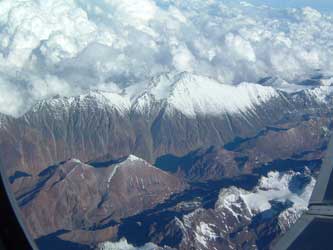 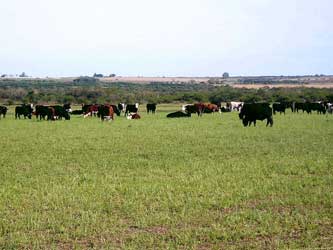 The Andes Mountains The Pampas With 20 National Parks, deserts, plains, mountains, and wildlife found nowhere else in the world, Argentina is immeasurably endowed with God’s natural treasures. Another special blessing, however, occurred nearly six decades ago, a time when even villagers in Puttaparthi had not recognized the Avatar in their midst, when one Argentinean lady came to Prasanthi Nilayam for Sai Baba’s darshan. The year was 1948. Extraordinary Blessings in the Early Years Adelina del Carril de Güiraldes was invited by a Maharani (Indian Queen), a Sai Baba devotee, to meet the twenty-two-year-old Swami. Adelina, wife of Ricardo Güiraldes, a famous Argentine novelist and poet, had been living in India for sometime and was dedicated to the spiritual path and to translating Indian scriptures into Spanish. When she encountered Baba for the first time, she realized, “Here was the One of whom the epic scriptures have been written.” Her heart filled with divine experiences, she returned to Argentina in 1951, taking with her Sai Baba’s materializations and many thrilling stories. In those days, Bhagavan would keep in contact with certain devotees by post. So it was with this fortunate lady, whom He affectionately called by the nickname “Mamina” or “Mamitha.” On one envelope, He wrote in his own hand, “Mamitha” – Pasupathi Kultiram, Sri Sathya Sai Baba High School Committee, Bukkapatnam.” This was a printed invitation, headed by a small photo of Him, inviting her to the inauguration of that school. Swami added, “Sri Sathya Sai Baba’s Blessings to Mamita and Ramu from Sathya Sai Baba of Puttaparthi. How is your health, Mamita?” The date is 8 August 1950. There are a number of letters, all handwritten and addressed to Mamina, dated 22 January 1949, 11 September 1949, 30 March 1951, 9 June 1951, and 16 December 1951. The Andes Mountains The Pampas With 20 National Parks, deserts, plains, mountains, and wildlife found nowhere else in the world, Argentina is immeasurably endowed with God’s natural treasures. Another special blessing, however, occurred nearly six decades ago, a time when even villagers in Puttaparthi had not recognized the Avatar in their midst, when one Argentinean lady came to Prasanthi Nilayam for Sai Baba’s darshan. The year was 1948. Extraordinary Blessings in the Early Years Adelina del Carril de Güiraldes was invited by a Maharani (Indian Queen), a Sai Baba devotee, to meet the twenty-two-year-old Swami. Adelina, wife of Ricardo Güiraldes, a famous Argentine novelist and poet, had been living in India for sometime and was dedicated to the spiritual path and to translating Indian scriptures into Spanish. When she encountered Baba for the first time, she realized, “Here was the One of whom the epic scriptures have been written.” Her heart filled with divine experiences, she returned to Argentina in 1951, taking with her Sai Baba’s materializations and many thrilling stories. In those days, Bhagavan would keep in contact with certain devotees by post. So it was with this fortunate lady, whom He affectionately called by the nickname “Mamina” or “Mamitha.” On one envelope, He wrote in his own hand, “Mamitha” – Pasupathi Kultiram, Sri Sathya Sai Baba High School Committee, Bukkapatnam.” This was a printed invitation, headed by a small photo of Him, inviting her to the inauguration of that school. Swami added, “Sri Sathya Sai Baba’s Blessings to Mamita and Ramu from Sathya Sai Baba of Puttaparthi. How is your health, Mamita?” The date is 8 August 1950. There are a number of letters, all handwritten and addressed to Mamina, dated 22 January 1949, 11 September 1949, 30 March 1951, 9 June 1951, and 16 December 1951. 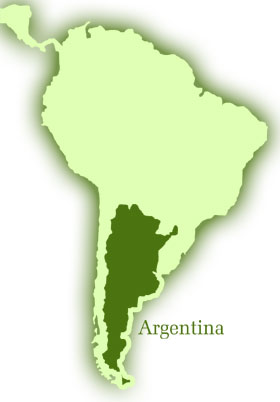 Argentina within South America Unique Blessings By Baba For Argentina Argentina within South America Unique Blessings By Baba For Argentina 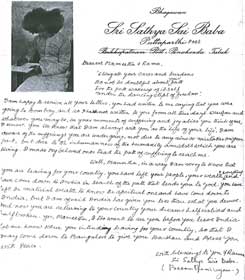 One of the many handwritten letters by Swami One of the many handwritten letters by Swami 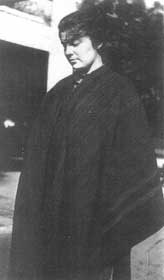 Adelina del Carril de Güiraldes That was the start of the fascinating tale of the Sai Movement in Argentina. Before revealing how Baba, through His mysterious ways and sublime love, inspired Argentineans living across the seas thousands of miles from Puttaparthi, let's look at this dynamic land, second only to Brazil in size in South America and the eighth largest country in the world. Adelina del Carril de Güiraldes That was the start of the fascinating tale of the Sai Movement in Argentina. Before revealing how Baba, through His mysterious ways and sublime love, inspired Argentineans living across the seas thousands of miles from Puttaparthi, let's look at this dynamic land, second only to Brazil in size in South America and the eighth largest country in the world. 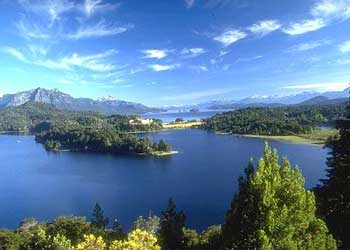 Lake Moreno Lake Moreno  Ventana al Submarino - San Juan Argentina – Gifted and Prosperous The name Argentina comes from the Latin Argentum, meaning silver. When the first Spanish conquistadors discovered the Rio de la Plata (an estuary on the South Atlantic coast), indigenous people gave gifts of silver to the survivors of the shipwrecked expedition. Even now, mining and exports of gold, silver, zinc, magnesium, and copper are growth industries. Apart from metals, agricultural exports (e.g. soy, vegetable oils) and manufacturing (motor vehicles, farm equipment, iron, and steel) constitute a large part of the nation’s GDP. More than any other Latin American country, Argentina’s population is of European origin, with most of the populace descended from Spanish, Italian and other European settlers, while the largest ethnic minority is the Mestizo (European/Amerindian). Argentina’s urban areas have a European look, and many cities in the triangle-shaped country are built in a Spanish-grid style around a main square called a plaza. Approximately 70% of its 38 million people declare themselves Roman Catholic, and Catholicism is endorsed in its constitution. At the same time, Argentina is home to one of the largest mosques in Latin America and a Muslim community of nearly six hundred thousand. Ventana al Submarino - San Juan Argentina – Gifted and Prosperous The name Argentina comes from the Latin Argentum, meaning silver. When the first Spanish conquistadors discovered the Rio de la Plata (an estuary on the South Atlantic coast), indigenous people gave gifts of silver to the survivors of the shipwrecked expedition. Even now, mining and exports of gold, silver, zinc, magnesium, and copper are growth industries. Apart from metals, agricultural exports (e.g. soy, vegetable oils) and manufacturing (motor vehicles, farm equipment, iron, and steel) constitute a large part of the nation’s GDP. More than any other Latin American country, Argentina’s population is of European origin, with most of the populace descended from Spanish, Italian and other European settlers, while the largest ethnic minority is the Mestizo (European/Amerindian). Argentina’s urban areas have a European look, and many cities in the triangle-shaped country are built in a Spanish-grid style around a main square called a plaza. Approximately 70% of its 38 million people declare themselves Roman Catholic, and Catholicism is endorsed in its constitution. At the same time, Argentina is home to one of the largest mosques in Latin America and a Muslim community of nearly six hundred thousand. 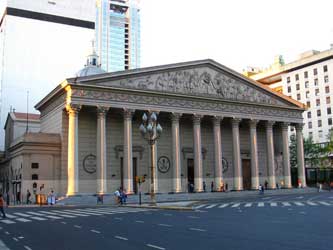 The Metropolitan Cathedral in Buenos Aires and.. The Metropolitan Cathedral in Buenos Aires and.. 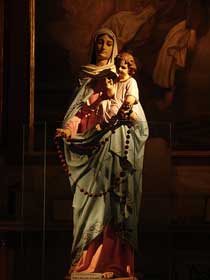 inside the famous Cathedral Spanish is the primary language, and a literacy rate of 97.5% puts the country high in global rankings. The ubiquitous white uniform of Argentine schoolchildren is a national emblem of learning. Except for graduate studies, education is free at all levels. inside the famous Cathedral Spanish is the primary language, and a literacy rate of 97.5% puts the country high in global rankings. The ubiquitous white uniform of Argentine schoolchildren is a national emblem of learning. Except for graduate studies, education is free at all levels. 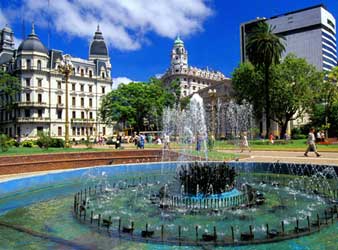 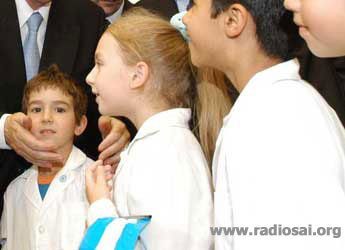 The Plaza de Mayo, Buenos Aires Argentinean school children in immaculate white From the Plains to the Port Though Argentina’s population is predominantly urban, with four fifths residing in cities and towns, the gaucho, the legendary cowboy and nomadic herder of the Pampas (as depicted in Martín Fierro, the Argentine folk epic by José Hernández) remains a national symbol. The nation’s industry, culture, and beauty converge in the capital, Buenos Aires, one of the most modern cities in the world. Often hailed as the “Paris of the South,” Buenos Aires gracefully combines space-age high technology with a rich colonial past. Home to more than a third of the country’s people, this cosmopolitan metropolis is the nation’s largest city. Its port is one of the busiest in the world, and the people of Buenos Aires are known as porteños (people of the port), acknowledging the historical importance the port has played in the nation’s development. Avenida 9 de Julio in Buenos Aires commemorates Argentina’s independence from Spain on 9 July 1816 and is said to be the world’s widest boulevard. The Cathedral containing the tomb of José de San Martín is another popular landmark. The Plaza de Mayo, Buenos Aires Argentinean school children in immaculate white From the Plains to the Port Though Argentina’s population is predominantly urban, with four fifths residing in cities and towns, the gaucho, the legendary cowboy and nomadic herder of the Pampas (as depicted in Martín Fierro, the Argentine folk epic by José Hernández) remains a national symbol. The nation’s industry, culture, and beauty converge in the capital, Buenos Aires, one of the most modern cities in the world. Often hailed as the “Paris of the South,” Buenos Aires gracefully combines space-age high technology with a rich colonial past. Home to more than a third of the country’s people, this cosmopolitan metropolis is the nation’s largest city. Its port is one of the busiest in the world, and the people of Buenos Aires are known as porteños (people of the port), acknowledging the historical importance the port has played in the nation’s development. Avenida 9 de Julio in Buenos Aires commemorates Argentina’s independence from Spain on 9 July 1816 and is said to be the world’s widest boulevard. The Cathedral containing the tomb of José de San Martín is another popular landmark. 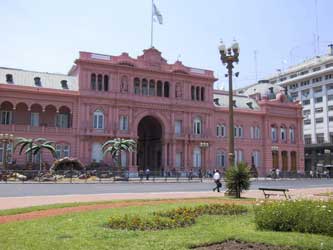 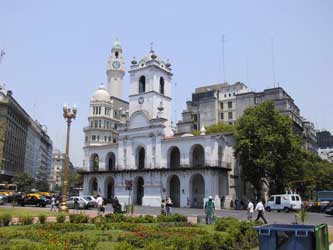 The Casa Rosada - the Presidential Palace The Cabildo - historic government house, now a musuem There are many more interesting aspects to Buenos Aires and Argentina, such as their culture, sports, music, flora, and fauna, but our focus is on how the Sai Movement developed in this South Atlantic nation. Argentina has twenty-three provinces, but the Sai Organization’s Central Council of Latin America has divided the country into six regions. First, we look at the Sai Movement in Buenos Aires and Córdoba; then we explore Cuyo, Bariloche, Northeast, and Sante Fe. The Genesis of the Sai Organization in Córdoba and Buenos Aires Though Adelina del Carril de Güiraldes visited Baba in 1948, more seeds were sown in 1978 with Ananda Giri. In 1969, Ananda Giri came to know of Baba from Indra Devi, the famous yoga teacher, when he lived in the Los Angeles ashram of Paramahansa Yogananda. It was there, in 1978, that Dick Bock gave him a copy of Aura of Divinity, one of the first films about Baba, shortly before he returned to Argentina. Ananda Giri, a yoga teacher, settled in Villa Carlos Paz, in the lovely Mediterranean-like region of Córdoba, a province characterized by stately mountains rising by calm and transparent lakes. (The city of Córdoba has a belt of historical heritage buildings, some of which date back to the Jesuits, who founded La Docta, the first university in the country.) Ananda Giri, inspired by his friend Kriyananda and the personality of Paramahansa Yogananda, decided to organize a spiritual tour of India in 1979, with one stop at Prasanthi Nilayam_._ He screened Aura of Divinity in Buenos Aires and Córdoba. Two seekers on this pilgrimage were Monica Zocolosky and Marta Basan. Eventually, it would be Monica who started the first Sai Center in Argentina, while Marta remained in India and lived in Prashanti Nilayam for fifteen years. Even before Ananda Giri organized the trip to India, Monica Zocolosky had experiences of Sai Baba. One day, she came across a pamphlet about Baba in Buenos Aires, but there was no photograph. She began having dreams of a man in orange, who she thought was her guardian angel. Later, Monica heard of a divine incarnation in India named Sathya Sai Baba. Shortly after, she was in a bookstore when a book fell on her head. It was Sai Baba, the Holy Man and the Psychiatrist, and it opened to a page with Sai Baba’s photograph. Monica instantly recognized Baba as the one who had been appearing in her dreams. “Many miracles will happen” - Baba When Ananda Giri arranged the trip to India, Monica joined in hopes of securing an interview with Sai Baba. After reaching Prasanthi, days passed with no interview, but she had a dream in which Baba told her she was to help Him in Latin America and that He was going to give her instructions and promised her an interview the next day. As promised, she was called in. Baba indicated she should return to Argentina and open a Sai Center in Buenos Aires. Monica, however, did not know how to organize a Sai Center and expressed her doubts. Baba assured her, “Don’t worry. Many miracles will happen.” This was the first of many divine instructions, direct and indirect, which led to the unfolding of the Sai Movement in Argentina. On her homeward journey, Monica stopped in London, where she lodged with an Indian couple who happened to be Sai devotees. They taught her everything she needed to know about running a Sai Center. Back in Buenos Aires, Monica opened the first Baba Center in Argentina in her home, putting to use what she had learned in London. The Casa Rosada - the Presidential Palace The Cabildo - historic government house, now a musuem There are many more interesting aspects to Buenos Aires and Argentina, such as their culture, sports, music, flora, and fauna, but our focus is on how the Sai Movement developed in this South Atlantic nation. Argentina has twenty-three provinces, but the Sai Organization’s Central Council of Latin America has divided the country into six regions. First, we look at the Sai Movement in Buenos Aires and Córdoba; then we explore Cuyo, Bariloche, Northeast, and Sante Fe. The Genesis of the Sai Organization in Córdoba and Buenos Aires Though Adelina del Carril de Güiraldes visited Baba in 1948, more seeds were sown in 1978 with Ananda Giri. In 1969, Ananda Giri came to know of Baba from Indra Devi, the famous yoga teacher, when he lived in the Los Angeles ashram of Paramahansa Yogananda. It was there, in 1978, that Dick Bock gave him a copy of Aura of Divinity, one of the first films about Baba, shortly before he returned to Argentina. Ananda Giri, a yoga teacher, settled in Villa Carlos Paz, in the lovely Mediterranean-like region of Córdoba, a province characterized by stately mountains rising by calm and transparent lakes. (The city of Córdoba has a belt of historical heritage buildings, some of which date back to the Jesuits, who founded La Docta, the first university in the country.) Ananda Giri, inspired by his friend Kriyananda and the personality of Paramahansa Yogananda, decided to organize a spiritual tour of India in 1979, with one stop at Prasanthi Nilayam_._ He screened Aura of Divinity in Buenos Aires and Córdoba. Two seekers on this pilgrimage were Monica Zocolosky and Marta Basan. Eventually, it would be Monica who started the first Sai Center in Argentina, while Marta remained in India and lived in Prashanti Nilayam for fifteen years. Even before Ananda Giri organized the trip to India, Monica Zocolosky had experiences of Sai Baba. One day, she came across a pamphlet about Baba in Buenos Aires, but there was no photograph. She began having dreams of a man in orange, who she thought was her guardian angel. Later, Monica heard of a divine incarnation in India named Sathya Sai Baba. Shortly after, she was in a bookstore when a book fell on her head. It was Sai Baba, the Holy Man and the Psychiatrist, and it opened to a page with Sai Baba’s photograph. Monica instantly recognized Baba as the one who had been appearing in her dreams. “Many miracles will happen” - Baba When Ananda Giri arranged the trip to India, Monica joined in hopes of securing an interview with Sai Baba. After reaching Prasanthi, days passed with no interview, but she had a dream in which Baba told her she was to help Him in Latin America and that He was going to give her instructions and promised her an interview the next day. As promised, she was called in. Baba indicated she should return to Argentina and open a Sai Center in Buenos Aires. Monica, however, did not know how to organize a Sai Center and expressed her doubts. Baba assured her, “Don’t worry. Many miracles will happen.” This was the first of many divine instructions, direct and indirect, which led to the unfolding of the Sai Movement in Argentina. On her homeward journey, Monica stopped in London, where she lodged with an Indian couple who happened to be Sai devotees. They taught her everything she needed to know about running a Sai Center. Back in Buenos Aires, Monica opened the first Baba Center in Argentina in her home, putting to use what she had learned in London. 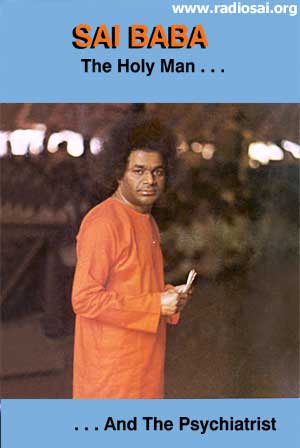 Jorge Hadad, President of the Sai Organization in Argentina for several years, says, “After news about the Sai Avatar came to Argentina in 1980 from Ananda Giri, the first Sai Centers were founded in Buenos Aires and Córdoba. Later, Sai groups started up in Mendoza and other provinces.” By 1981, in order to accommodate the growing numbers attending the Buenos Aires Center, a house was rented on Paraguay Street. Activities at the Sai Center on Paraguay Street included devotional singing, a Bal Vikas group, seva projects, and film showings on Sai Baba. How the Largest Sai Center in Latin America was Born Mr. Hugo Baldi visited Swami for the first time with his family in 1981. Upon returning, along with other new devotees, he began performing extensive service. Hugo relates, “When the devotees decided to buy an abandoned mechanic’s shop on Uriarte Street and move the Paraguay Street Center there, I was initially opposed to the idea, until I had a dream in which Swami and I entered the workshop and He began to dance. This confirmed to me that the Uriarte street building was the appropriate location.” The workshop required a great deal of remodeling, but it has since become the largest Sai Center in Latin America, often with 400 devotees in attendance. Jorge Hadad, President of the Sai Organization in Argentina for several years, says, “After news about the Sai Avatar came to Argentina in 1980 from Ananda Giri, the first Sai Centers were founded in Buenos Aires and Córdoba. Later, Sai groups started up in Mendoza and other provinces.” By 1981, in order to accommodate the growing numbers attending the Buenos Aires Center, a house was rented on Paraguay Street. Activities at the Sai Center on Paraguay Street included devotional singing, a Bal Vikas group, seva projects, and film showings on Sai Baba. How the Largest Sai Center in Latin America was Born Mr. Hugo Baldi visited Swami for the first time with his family in 1981. Upon returning, along with other new devotees, he began performing extensive service. Hugo relates, “When the devotees decided to buy an abandoned mechanic’s shop on Uriarte Street and move the Paraguay Street Center there, I was initially opposed to the idea, until I had a dream in which Swami and I entered the workshop and He began to dance. This confirmed to me that the Uriarte street building was the appropriate location.” The workshop required a great deal of remodeling, but it has since become the largest Sai Center in Latin America, often with 400 devotees in attendance. 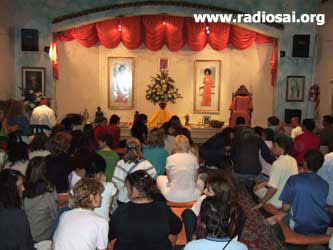 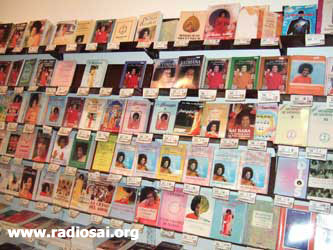 The Uriarte Sai Centre Bhajan Hall The Bookshop at the Uriarte Sai Centre In 1983, a group from the Paraguay Center traveled to India, and after this visit the budding Sai Organization began to blossom. In 1986, Sai devotees rented a stand at an International Book Fair and sold books, gave away brochures, and screened movies on Sai Baba. In 1989, Monica led the way in organizing a huge public Sai Baba gathering. Held at the Obras Sanitarias Stadium in Buenos Aires, the event included popular artists and musical stars and featured the famous songwriter and singer Alejandro Lerner and a young actress cum singer, Marilina Ross. They co-starred in a musical play, Who Am I. Five thousand people packed the stadium with at least 2,500 more watching the show on large TV screens outside. It was a grand success and generated greater awareness of Baba and His message. Sai books were sold and pamphlets with information about the centers and their activities were distributed at this free event. 1985 brought a new Sai Baba Center in Córdoba with a multi-faith stupa like the one in Prashanti Nilayam. Richard and Janet Bock’s film, The Aura of Divinity, helped spread Sai’s message and centers sprung up in Córdoba province and many others, such as La Rioja, Catamarca, Tucumán, Santa Fe, La Pampa, Entre Ríos and Chubut. Argentinean television aired the Bock’s film every three months in different sections of the country and discussion groups were organized to share Sai Baba’s teachings. All these efforts brought more people into the Sai fold. The Uriarte Sai Centre Bhajan Hall The Bookshop at the Uriarte Sai Centre In 1983, a group from the Paraguay Center traveled to India, and after this visit the budding Sai Organization began to blossom. In 1986, Sai devotees rented a stand at an International Book Fair and sold books, gave away brochures, and screened movies on Sai Baba. In 1989, Monica led the way in organizing a huge public Sai Baba gathering. Held at the Obras Sanitarias Stadium in Buenos Aires, the event included popular artists and musical stars and featured the famous songwriter and singer Alejandro Lerner and a young actress cum singer, Marilina Ross. They co-starred in a musical play, Who Am I. Five thousand people packed the stadium with at least 2,500 more watching the show on large TV screens outside. It was a grand success and generated greater awareness of Baba and His message. Sai books were sold and pamphlets with information about the centers and their activities were distributed at this free event. 1985 brought a new Sai Baba Center in Córdoba with a multi-faith stupa like the one in Prashanti Nilayam. Richard and Janet Bock’s film, The Aura of Divinity, helped spread Sai’s message and centers sprung up in Córdoba province and many others, such as La Rioja, Catamarca, Tucumán, Santa Fe, La Pampa, Entre Ríos and Chubut. Argentinean television aired the Bock’s film every three months in different sections of the country and discussion groups were organized to share Sai Baba’s teachings. All these efforts brought more people into the Sai fold. 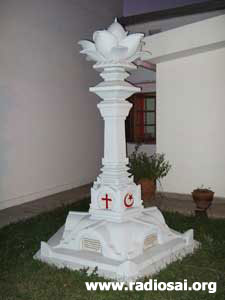 The Stupa at Cordoba Centre The Sai Movement Grows Swiftly The first Coordinating Committee for the Sai Organization of Argentina was established in 1986, with Hugo Baldi as President. Over the next year, the Organization swiftly expanded. Service projects, devotional singing, and human values lessons for children and adults inspired members across the country. The Sathya Sai Baba Foundation of Argentina was established to assist the multifarious service activities. Also, in 1987, the Central Council of Latin America was created at a meeting in Buenos Aires, which drew representatives from the entire continent. Leonardo Gutter and Nassin Michaan were nominated as Central Coordinators. How Leonardo Gutter came to Baba is a fascinating tale. He heard about Sai Baba while participating in a spiritual group (Sudda Darma Madalam) started by Monica Zocolosky. A powerful dream with Swami led to his first trip to India in 1982. After forty days of waiting and hoping for an interview, Leonardo decided to resign from the other spiritual group. As soon as he did so, Baba called him in. After answering Leonardo’s personal questions, Baba whispered in his ear, “Sai Baba is never going to disappoint His devotees.”Returning to Argentina, the reinvigorated Leonardo shared Sai Baba’s love and message, taking an active part in the evolutionary process of the Sai Organization of Latin America. Before leaving India that year, he hoped to return in September, though he did not have the funds for another trip. Then, while on a business trip to Ecuador, after speaking about Baba at a luncheon, a businessman asked him to accompany him to India in September. Leonardo was pleasantly surprised, and the next day the man bought their air tickets. The businessman had terminal cancer of the mouth, which Baba cured. Back in Ecuador, he printed a magazine with his wonderful experiences and distributed 10,000 free copies. On a subsequent trip to India, Leonardo broke his nose a few days before leaving. Because it was too late to cancel the trip, he traveled with a broken nose. He also came down with a cold, and when he had to sneeze, it felt like his nose was breaking off. He couldn’t he blow his nose, and the air conditioning on the airplanes only worsened his plight. When he arrived at Prasanthi, Baba called him for an interview. Leo was sitting besides Swami’s chair when Baba suddenly grabbed his nose between His forefinger and middle finger and shook his whole head! The pain was excruciating, though only for a minute, and Leo thought his nose would come off. But then he felt calm and free from pain. Swami had healed the broken nose. “Watch” Your Thoughts On another occasion, Leonardo wanted proof that Swami was God. In his room in the ashram, he said, “Swami, if you are God, you can make me a watch.” Leo had a wristwatch, which he put it on the table by his bed that night. The next morning, it was gone. The Stupa at Cordoba Centre The Sai Movement Grows Swiftly The first Coordinating Committee for the Sai Organization of Argentina was established in 1986, with Hugo Baldi as President. Over the next year, the Organization swiftly expanded. Service projects, devotional singing, and human values lessons for children and adults inspired members across the country. The Sathya Sai Baba Foundation of Argentina was established to assist the multifarious service activities. Also, in 1987, the Central Council of Latin America was created at a meeting in Buenos Aires, which drew representatives from the entire continent. Leonardo Gutter and Nassin Michaan were nominated as Central Coordinators. How Leonardo Gutter came to Baba is a fascinating tale. He heard about Sai Baba while participating in a spiritual group (Sudda Darma Madalam) started by Monica Zocolosky. A powerful dream with Swami led to his first trip to India in 1982. After forty days of waiting and hoping for an interview, Leonardo decided to resign from the other spiritual group. As soon as he did so, Baba called him in. After answering Leonardo’s personal questions, Baba whispered in his ear, “Sai Baba is never going to disappoint His devotees.”Returning to Argentina, the reinvigorated Leonardo shared Sai Baba’s love and message, taking an active part in the evolutionary process of the Sai Organization of Latin America. Before leaving India that year, he hoped to return in September, though he did not have the funds for another trip. Then, while on a business trip to Ecuador, after speaking about Baba at a luncheon, a businessman asked him to accompany him to India in September. Leonardo was pleasantly surprised, and the next day the man bought their air tickets. The businessman had terminal cancer of the mouth, which Baba cured. Back in Ecuador, he printed a magazine with his wonderful experiences and distributed 10,000 free copies. On a subsequent trip to India, Leonardo broke his nose a few days before leaving. Because it was too late to cancel the trip, he traveled with a broken nose. He also came down with a cold, and when he had to sneeze, it felt like his nose was breaking off. He couldn’t he blow his nose, and the air conditioning on the airplanes only worsened his plight. When he arrived at Prasanthi, Baba called him for an interview. Leo was sitting besides Swami’s chair when Baba suddenly grabbed his nose between His forefinger and middle finger and shook his whole head! The pain was excruciating, though only for a minute, and Leo thought his nose would come off. But then he felt calm and free from pain. Swami had healed the broken nose. “Watch” Your Thoughts On another occasion, Leonardo wanted proof that Swami was God. In his room in the ashram, he said, “Swami, if you are God, you can make me a watch.” Leo had a wristwatch, which he put it on the table by his bed that night. The next morning, it was gone. 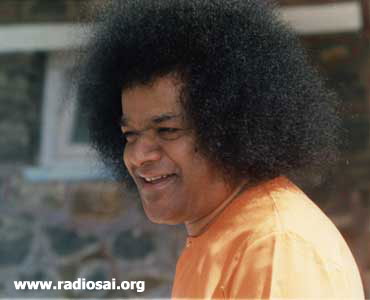 He waited thirty days, and just before leaving for Argentina, while debating whether or not to buy another one, Baba called him in and materialized a beautiful watch. He said, “This is a special watch. It will stop every time you have a bad thought.” During the interview, the watch stopped. Leonardo was surprised and told Baba, “The watch has stopped!” Swami said, “Yes, because you had a bad thought.” Ever since then, Leonardo has been watching his thoughts to keep the watch running. The ways of the divine are truly astounding. The Wonder of His Omnipresence Over the next few years, the Central Council of Latin America established Coordinating Committees in many countries, creating a base for the continued growth of the Sai movement. By 1992, the numbers had grown to seventeen Sai Centers and forty-six Sai Groups in the Argentine territory. In 1998, the first Central Council of Argentina and six Regional Coordinating Committees were established, with Jorge Hadad of Córdoba as its first president. “Often when we traveled to project Sai’s films,” says Mr. Haddad, “we smelled the aroma of incense or a marvelous jasmine fragrance inside the cars, the hotels, and in the public hall, though no one had lit any incense. In numerous ways, Sai’s presence was always felt.” “Several years ago,” Mr. Hadad continues, “It was announced that a film on Sai Baba would be screened in a hall in Jesús María, a locality in the province of Córdoba. Before the announced hour, to the delight and astonishment of those who saw and tasted this divine manifestation, a sweet liquid with the scent of flowers began exuding from a photo of Sai Baba at the entrance of the hall. Another of the Lord’s leelas occurred at the Sai Center of Córdoba. While chanting 108 Gayatris before the devotional singing, a lady there felt something strange in her hand. When she stepped outside into broad daylight, she noticed her wedding ring had disappeared and on her finger shone a ring with the symbols of the world’s religions; a powerful wish of hers had been fulfilled. Also, her fingers were covered with fragrant vibhuti. This was witnessed by many others who were accompanying her. To complete her amazement and joy, when she arrived home, she found her wedding ring was safely in a box.” Mr. Hadad also mentioned a group of drug-addicted young adults who occasionally came to the Sai Center, and how through Baba’s divine grace they overcame their addiction. Today, they are healthy members of society. Many such divine leelas along with the uplifting effects of the seva (selfless service) activities propelled the Organization’s quick growth. Similar events brought people from the regions of Cuyo and Bariloche to Baba. He waited thirty days, and just before leaving for Argentina, while debating whether or not to buy another one, Baba called him in and materialized a beautiful watch. He said, “This is a special watch. It will stop every time you have a bad thought.” During the interview, the watch stopped. Leonardo was surprised and told Baba, “The watch has stopped!” Swami said, “Yes, because you had a bad thought.” Ever since then, Leonardo has been watching his thoughts to keep the watch running. The ways of the divine are truly astounding. The Wonder of His Omnipresence Over the next few years, the Central Council of Latin America established Coordinating Committees in many countries, creating a base for the continued growth of the Sai movement. By 1992, the numbers had grown to seventeen Sai Centers and forty-six Sai Groups in the Argentine territory. In 1998, the first Central Council of Argentina and six Regional Coordinating Committees were established, with Jorge Hadad of Córdoba as its first president. “Often when we traveled to project Sai’s films,” says Mr. Haddad, “we smelled the aroma of incense or a marvelous jasmine fragrance inside the cars, the hotels, and in the public hall, though no one had lit any incense. In numerous ways, Sai’s presence was always felt.” “Several years ago,” Mr. Hadad continues, “It was announced that a film on Sai Baba would be screened in a hall in Jesús María, a locality in the province of Córdoba. Before the announced hour, to the delight and astonishment of those who saw and tasted this divine manifestation, a sweet liquid with the scent of flowers began exuding from a photo of Sai Baba at the entrance of the hall. Another of the Lord’s leelas occurred at the Sai Center of Córdoba. While chanting 108 Gayatris before the devotional singing, a lady there felt something strange in her hand. When she stepped outside into broad daylight, she noticed her wedding ring had disappeared and on her finger shone a ring with the symbols of the world’s religions; a powerful wish of hers had been fulfilled. Also, her fingers were covered with fragrant vibhuti. This was witnessed by many others who were accompanying her. To complete her amazement and joy, when she arrived home, she found her wedding ring was safely in a box.” Mr. Hadad also mentioned a group of drug-addicted young adults who occasionally came to the Sai Center, and how through Baba’s divine grace they overcame their addiction. Today, they are healthy members of society. Many such divine leelas along with the uplifting effects of the seva (selfless service) activities propelled the Organization’s quick growth. Similar events brought people from the regions of Cuyo and Bariloche to Baba. 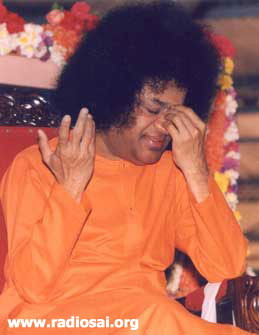 Sai’s Message Comes to Cuyo The region of Cuyo is situated at the bottom of the Andes Mountains, looked over by the 7000-meter high Aconcagua Mountain, also known as the Stone Sentinel, the highest peak in the Americas. This region of deserts and oases was the setting for a spiritual resurgence in Argentina. After the first devotees from Buenos Aires went to visit Baba in the early 80s, they generated a stream of Sai Love through public meetings. Enrique Giaquinta and Norma Galar were among those who set up the first center in Cuyo. In the city of Bariloche, a tourist destination situated on a lake in the foothills of the Andes in South Argentina, Hugo Baldi began showing Aura of Divinity in his ‘Interlaken Hotel’. Carlos Bastias was one of many who were moved, and with Mercedes Wesley, he started the first Sai Center in Bariloche. Mercedes later became one of the principal translators of Sai literature into Spanish. Translators Mercedes Wesley, Arlette Meyer from Venezuela, and Herta Pfifer from Chile, are largely responsible for making a number of books on Baba available to the people of Latin America in their language. Publishing the books has been a labor of love undertaken by Ricardo Parada from Buenos Aires, Luis Muniz from Mexico, and Arnoldo Zarate of Venezuela. The Word Spreads in Spanish In the 1960s, Ricardo Parada read the predictions of an American clairvoyant who said there was an extraordinary person born in the East whose mission would be to unite all of humanity. The prophecy stated that from 1985 this great teacher would be known throughout the world. When Ricardo saw an article on Sai Baba, he was certain this was the promised teacher the clairvoyant had spoken of. At the end of 1987, Ricardo planned his first trip to India. In Prasanthi Nilayam, Baba called him for an interview and blessed the work of publishing Sai books in Spanish. On his return to Argentina, Ricardo, a partner in a firm specializing in publishing accounting books, had to overcome the resistance of his associates who thought bringing out spiritual volumes would ruin their business. Ricardo finally convinced them to try it with a few titles. The company grew quickly in a way no one could have imagined, and within four years they were the publishers of a catalogue of Sai books. At a publisher’s conference in Prasanthi Nilayam in 2005, Ricardo showed how his company had managed to publish over 200 titles with Baba’s message for Spanish speaking countries. He said, “It is wonderful how Swami makes everything necessary for this work available without anyone asking Him.” Sai Travels to Corners of Argentina Sai’s Message Comes to Cuyo The region of Cuyo is situated at the bottom of the Andes Mountains, looked over by the 7000-meter high Aconcagua Mountain, also known as the Stone Sentinel, the highest peak in the Americas. This region of deserts and oases was the setting for a spiritual resurgence in Argentina. After the first devotees from Buenos Aires went to visit Baba in the early 80s, they generated a stream of Sai Love through public meetings. Enrique Giaquinta and Norma Galar were among those who set up the first center in Cuyo. In the city of Bariloche, a tourist destination situated on a lake in the foothills of the Andes in South Argentina, Hugo Baldi began showing Aura of Divinity in his ‘Interlaken Hotel’. Carlos Bastias was one of many who were moved, and with Mercedes Wesley, he started the first Sai Center in Bariloche. Mercedes later became one of the principal translators of Sai literature into Spanish. Translators Mercedes Wesley, Arlette Meyer from Venezuela, and Herta Pfifer from Chile, are largely responsible for making a number of books on Baba available to the people of Latin America in their language. Publishing the books has been a labor of love undertaken by Ricardo Parada from Buenos Aires, Luis Muniz from Mexico, and Arnoldo Zarate of Venezuela. The Word Spreads in Spanish In the 1960s, Ricardo Parada read the predictions of an American clairvoyant who said there was an extraordinary person born in the East whose mission would be to unite all of humanity. The prophecy stated that from 1985 this great teacher would be known throughout the world. When Ricardo saw an article on Sai Baba, he was certain this was the promised teacher the clairvoyant had spoken of. At the end of 1987, Ricardo planned his first trip to India. In Prasanthi Nilayam, Baba called him for an interview and blessed the work of publishing Sai books in Spanish. On his return to Argentina, Ricardo, a partner in a firm specializing in publishing accounting books, had to overcome the resistance of his associates who thought bringing out spiritual volumes would ruin their business. Ricardo finally convinced them to try it with a few titles. The company grew quickly in a way no one could have imagined, and within four years they were the publishers of a catalogue of Sai books. At a publisher’s conference in Prasanthi Nilayam in 2005, Ricardo showed how his company had managed to publish over 200 titles with Baba’s message for Spanish speaking countries. He said, “It is wonderful how Swami makes everything necessary for this work available without anyone asking Him.” Sai Travels to Corners of Argentina 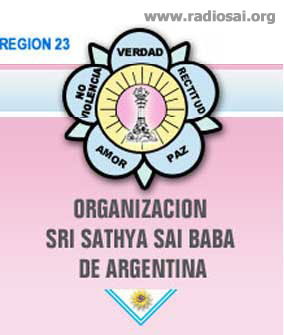 Atilio Spinello from Mendoza, a province in the Cuyo region, was given permission by Swami to make several films in the ashram, and these were widely viewed, bringing new devotees into the Sai fold in these regions. In 1989, Beatriz Celerino traveled to India and Swami told her to start a group in Tucuman, in the region of Noreste (North East). She protested, saying no one knew about Swami there. But Swami promised to help. Little by little the group was formed, and she traveled to the provinces of Jujuy and Salta, where additional groups were started. Today these are strong centers with over 40 members. In the Santa Fe regions, the Sai movement was promoted by Ernesto Massin, a former catholic priest, and his wife, Albina Keppl. Ernesto penned the book, Jesus and Sai Baba, a comparison of both teachings. With other devotees, the couple started a community service center at Noccan Kani to aid families of the Toba community and help make them self-sufficient. By 2000, when Leonardo Gutter was named Chair of the Latin American Sai Organization, the Sai movement in Latin America had thousands of devotees. Leonardo’s stimulating talks attracted numerous seekers to the Sai fold. Baba blessed Leonardo with many spiritual experiences and gave him opportunities to speak in His presence in Prasanthi Nilayam. In 2004, when the Prasanthi Council was formed to oversee the Sai Organizations worldwide, Leonardo was named one of its members. The Sarva Dharma Logo with the Five Values in Spanish After this brief history of the Sai Organization in a few regions of Argentina, we move on to the activities — service, educational, spiritual and others — being undertaken by the country’s Sai community. Argentina – Marching Ahead in Educare Education in Human Values has become a major activity of the Argentinean Sai movement. Recently, the Minister of Education of Argentina met the Director of the Sathya Sai Institute of Argentina and approved the Sathya Sai EHV Program. In fact, she requested the Director of the Institute to adopt as many schools as possible, the only limit being the Sai Organization’s resources. Atilio Spinello from Mendoza, a province in the Cuyo region, was given permission by Swami to make several films in the ashram, and these were widely viewed, bringing new devotees into the Sai fold in these regions. In 1989, Beatriz Celerino traveled to India and Swami told her to start a group in Tucuman, in the region of Noreste (North East). She protested, saying no one knew about Swami there. But Swami promised to help. Little by little the group was formed, and she traveled to the provinces of Jujuy and Salta, where additional groups were started. Today these are strong centers with over 40 members. In the Santa Fe regions, the Sai movement was promoted by Ernesto Massin, a former catholic priest, and his wife, Albina Keppl. Ernesto penned the book, Jesus and Sai Baba, a comparison of both teachings. With other devotees, the couple started a community service center at Noccan Kani to aid families of the Toba community and help make them self-sufficient. By 2000, when Leonardo Gutter was named Chair of the Latin American Sai Organization, the Sai movement in Latin America had thousands of devotees. Leonardo’s stimulating talks attracted numerous seekers to the Sai fold. Baba blessed Leonardo with many spiritual experiences and gave him opportunities to speak in His presence in Prasanthi Nilayam. In 2004, when the Prasanthi Council was formed to oversee the Sai Organizations worldwide, Leonardo was named one of its members. The Sarva Dharma Logo with the Five Values in Spanish After this brief history of the Sai Organization in a few regions of Argentina, we move on to the activities — service, educational, spiritual and others — being undertaken by the country’s Sai community. Argentina – Marching Ahead in Educare Education in Human Values has become a major activity of the Argentinean Sai movement. Recently, the Minister of Education of Argentina met the Director of the Sathya Sai Institute of Argentina and approved the Sathya Sai EHV Program. In fact, she requested the Director of the Institute to adopt as many schools as possible, the only limit being the Sai Organization’s resources. 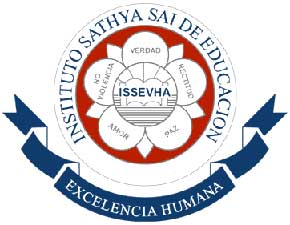 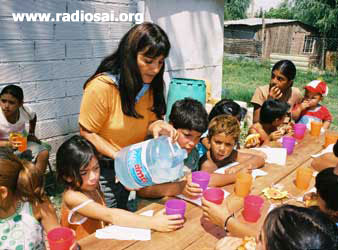 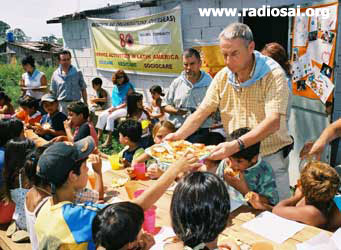 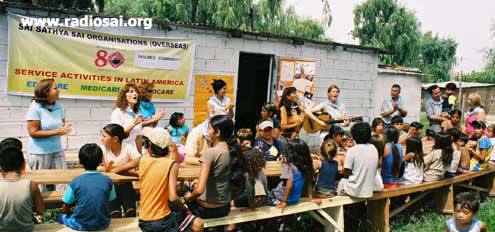 The fun-filled service at an after school EHV centre at La Casta Pioneering efforts by the Sai devotees culminated in this national recognition. Notable examples are: the daycare center in Córdoba, later converted into a Sai School managed by Jorge and Ana Haddad; Los Bichitos daycare center in Buenos Aires where up to ten devotees serve for five days a week; a program imparting human values lessons and training in skills like music and art for the children in La Boca, and others. Daniel Coifmann, who translated the first human values book, traveled extensively in Latin America introducing the EHV program to many countries. Serving the Quilmes community children The fun-filled service at an after school EHV centre at La Casta Pioneering efforts by the Sai devotees culminated in this national recognition. Notable examples are: the daycare center in Córdoba, later converted into a Sai School managed by Jorge and Ana Haddad; Los Bichitos daycare center in Buenos Aires where up to ten devotees serve for five days a week; a program imparting human values lessons and training in skills like music and art for the children in La Boca, and others. Daniel Coifmann, who translated the first human values book, traveled extensively in Latin America introducing the EHV program to many countries. Serving the Quilmes community children 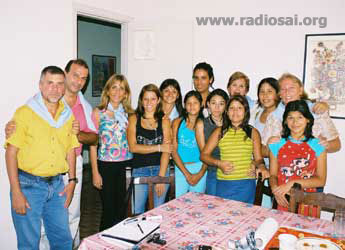 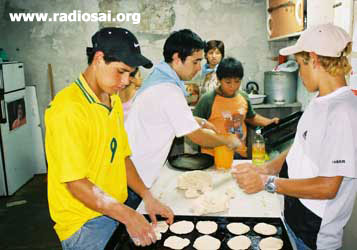 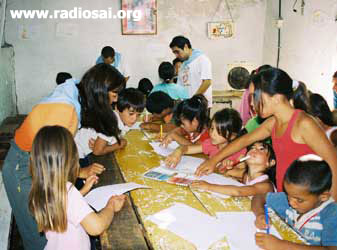 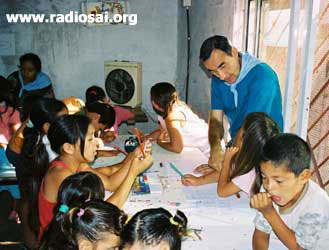 Miracles Clear the Way for the Mahatma Gandhi School In 2000, t he Educational Activities got a big boost when Ricardo Parada was asked to create an Institute of Education in Human Values with the goal of establishing new Sai Schools and administering those already functioning. A committee was formed to look for an appropriate site in Buenos Aires. Nothing suitable was found until Ricardo heard of a vacant school available at a reasonable price. It seemed a great opportunity, but being a bankruptcy sale, there were legal complications in the form of employee embargos against the property. Baba guided Ricardo in paying off the employees’ claims even before the title was cleared, and the transaction went off without a hitch. Renovations began in November 2000, but there were more hurdles to overcome before the school could open on its scheduled date in the first week of March 2001. Miracles Clear the Way for the Mahatma Gandhi School In 2000, t he Educational Activities got a big boost when Ricardo Parada was asked to create an Institute of Education in Human Values with the goal of establishing new Sai Schools and administering those already functioning. A committee was formed to look for an appropriate site in Buenos Aires. Nothing suitable was found until Ricardo heard of a vacant school available at a reasonable price. It seemed a great opportunity, but being a bankruptcy sale, there were legal complications in the form of employee embargos against the property. Baba guided Ricardo in paying off the employees’ claims even before the title was cleared, and the transaction went off without a hitch. Renovations began in November 2000, but there were more hurdles to overcome before the school could open on its scheduled date in the first week of March 2001. 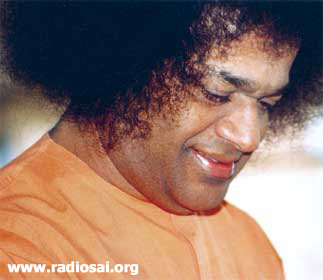 An authorization from the Department of Education of the Province was mandatory for the school to operate. Alberto Vasconcelos, future President of the Central Council, decided to speak personally with a high-level civil servant in the city of La Plata. When he sought an appointment, he was given a date weeks away. Alberto explained it was urgent and requested an earlier date but was told that was impossible. With no other option, Alberto sat in the office and prayed to Baba: “Swami, I am going to wait for You for thirty minutes, since You have shown that the project is very urgent.” Fifteen minutes passed, and a woman approached and asked, “Were you looking for me?” After confirming she was who he was looking for, Alberto explained, “We are opening a school in human values.” Interrupting him, she said, “Come to my office.” She called her secretary, opened the files, and authorized it on the spot, signing all necessary documents. It was unbelievable, but that was how the Mahatma Gandhi School was legally born. After his initial joy, Ricardo realized that although the authorization to open the school was obtained, the Institute had not yet been authorized by the Government Organization. Extremely concerned, he traveled to Prasanthi Nilayam and delivered a letter to Swami on15 January, explaining the situation. That same day, official approval for the Institute arrived, with all the stamps and corresponding dates, even though January is a month of judicial leave of absence for the entire country. This was yet another miracle, and all the obstacles were now cleared. An authorization from the Department of Education of the Province was mandatory for the school to operate. Alberto Vasconcelos, future President of the Central Council, decided to speak personally with a high-level civil servant in the city of La Plata. When he sought an appointment, he was given a date weeks away. Alberto explained it was urgent and requested an earlier date but was told that was impossible. With no other option, Alberto sat in the office and prayed to Baba: “Swami, I am going to wait for You for thirty minutes, since You have shown that the project is very urgent.” Fifteen minutes passed, and a woman approached and asked, “Were you looking for me?” After confirming she was who he was looking for, Alberto explained, “We are opening a school in human values.” Interrupting him, she said, “Come to my office.” She called her secretary, opened the files, and authorized it on the spot, signing all necessary documents. It was unbelievable, but that was how the Mahatma Gandhi School was legally born. After his initial joy, Ricardo realized that although the authorization to open the school was obtained, the Institute had not yet been authorized by the Government Organization. Extremely concerned, he traveled to Prasanthi Nilayam and delivered a letter to Swami on15 January, explaining the situation. That same day, official approval for the Institute arrived, with all the stamps and corresponding dates, even though January is a month of judicial leave of absence for the entire country. This was yet another miracle, and all the obstacles were now cleared. 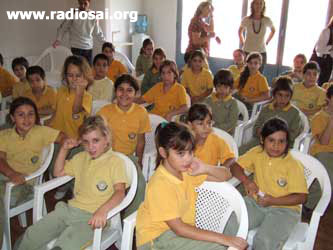  Girls of the Mahatma Gandhi School The boys are all keen to get on camera Although facing some opposition from the community and local religious institues, the school opened in March, just as Swami had indicated. The drama was not yet over, however, as the Commission of Schools mandated that by July they had to have fifteen children enrolled or their authorization would be canceled. The school had opened with only five students. Another request brought another miracle: the school had exactly fifteen students enrolled by July. Today, the Mahatma Gandhi School has 160 students and a long waiting list. A new Sai School is scheduled to open in 2007 in Mendoza, Cuyo. Multifarious Service Projects One of the reasons for the extraordinary growth of the Sai Organization in Argentina has been its numerous service projects. Describing these various activities, Leonardo Gutter said in a recent Radio Sai interview: “In Argentina, there are currently 80 to 90 centers and groups. A few centers are open 9:00 a.m. to 9:00 p.m. every day of the week. Their activities include daily seva (selfless service), study circles, and bhajans twice weekly. Three or four times a week, Narayan seva is conducted. In Buenos Aires, one center serves about 11,000 plates of food monthly to poor people. Other projects include conducting medical camps, adopting slum areas, visiting the lepers’ house, serving in the children’s hospital, etc. The important aspect is that all this is done with great love and is a continuous activity done throughout the week, every week.” Girls of the Mahatma Gandhi School The boys are all keen to get on camera Although facing some opposition from the community and local religious institues, the school opened in March, just as Swami had indicated. The drama was not yet over, however, as the Commission of Schools mandated that by July they had to have fifteen children enrolled or their authorization would be canceled. The school had opened with only five students. Another request brought another miracle: the school had exactly fifteen students enrolled by July. Today, the Mahatma Gandhi School has 160 students and a long waiting list. A new Sai School is scheduled to open in 2007 in Mendoza, Cuyo. Multifarious Service Projects One of the reasons for the extraordinary growth of the Sai Organization in Argentina has been its numerous service projects. Describing these various activities, Leonardo Gutter said in a recent Radio Sai interview: “In Argentina, there are currently 80 to 90 centers and groups. A few centers are open 9:00 a.m. to 9:00 p.m. every day of the week. Their activities include daily seva (selfless service), study circles, and bhajans twice weekly. Three or four times a week, Narayan seva is conducted. In Buenos Aires, one center serves about 11,000 plates of food monthly to poor people. Other projects include conducting medical camps, adopting slum areas, visiting the lepers’ house, serving in the children’s hospital, etc. The important aspect is that all this is done with great love and is a continuous activity done throughout the week, every week.” 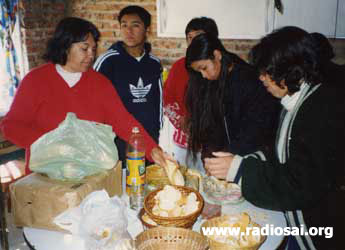 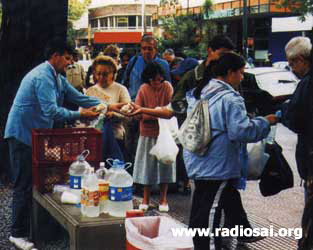 Narayan seva offerings being prepared Serving on the streets Narayan seva offerings being prepared Serving on the streets 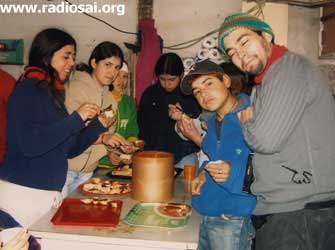 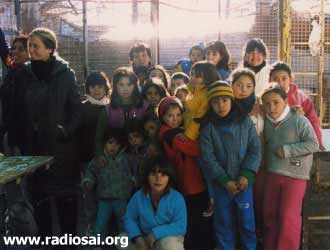 Dinning room service (left) and waiting for medical assistance in Florencia Varela, Province of Buenos Vires Gold from Heaven for the Helguera Girls’ Home Swami told Monica Socolosky in her first interview that many miracles would happen. One that stands out is this: In 1992, the Sri Sathya Sai Baba Foundation of Argentina was renting a Home for Children, which was providing shelter for street urchins and offering education and rehabilitation in a loving environment. One day, a boy from the home was cleaning flowerpots in order to plant new seeds and found two plastic bags with something wrapped in newspaper inside a pot. When he opened it to see what was inside, out fell two gold bars. The devotees consulted legal specialists to find out who the owner was. They were told the one who found it was the owner. So it seemed a street lad had become wealthy overnight. To get further clarification and directions regarding the ownership and usage of this newfound wealth, the President of the Sai Foundation of Argentina, along with the boy and other devotees, traveled to Prasanthi Nilayam. Baba granted them an interview and told them that the gold was a product of His Will and should be used to buy a home for the orphans. Through the sale of the gold bars and donations, the Foundation was able to purchase a house on Helguera Street, now the Girls’ Sai Home. This home shelters nine girls and is supported by the Sathya Sai Baba Foundation. All of them come from unstable families and were assigned to the Home by a judge from the Ministry of Justice. They are provided a family environment, education, loving care, and medical assistance. Three female seva dal workers live with the girls, who participate in Sai Center activities and go to the church of their choice. In September, 1993, a second house was purchased on Costa Rica Street for use as a Service Center. Dinning room service (left) and waiting for medical assistance in Florencia Varela, Province of Buenos Vires Gold from Heaven for the Helguera Girls’ Home Swami told Monica Socolosky in her first interview that many miracles would happen. One that stands out is this: In 1992, the Sri Sathya Sai Baba Foundation of Argentina was renting a Home for Children, which was providing shelter for street urchins and offering education and rehabilitation in a loving environment. One day, a boy from the home was cleaning flowerpots in order to plant new seeds and found two plastic bags with something wrapped in newspaper inside a pot. When he opened it to see what was inside, out fell two gold bars. The devotees consulted legal specialists to find out who the owner was. They were told the one who found it was the owner. So it seemed a street lad had become wealthy overnight. To get further clarification and directions regarding the ownership and usage of this newfound wealth, the President of the Sai Foundation of Argentina, along with the boy and other devotees, traveled to Prasanthi Nilayam. Baba granted them an interview and told them that the gold was a product of His Will and should be used to buy a home for the orphans. Through the sale of the gold bars and donations, the Foundation was able to purchase a house on Helguera Street, now the Girls’ Sai Home. This home shelters nine girls and is supported by the Sathya Sai Baba Foundation. All of them come from unstable families and were assigned to the Home by a judge from the Ministry of Justice. They are provided a family environment, education, loving care, and medical assistance. Three female seva dal workers live with the girls, who participate in Sai Center activities and go to the church of their choice. In September, 1993, a second house was purchased on Costa Rica Street for use as a Service Center. 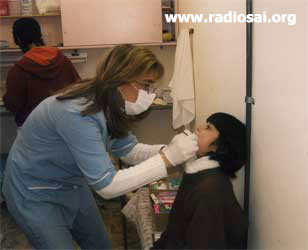 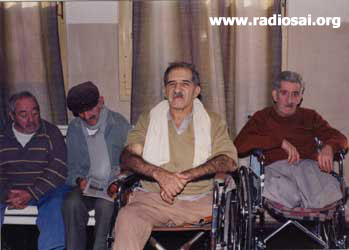 Dental Seva to the underprivileged Service at an old people's home Dental Seva to the underprivileged Service at an old people's home 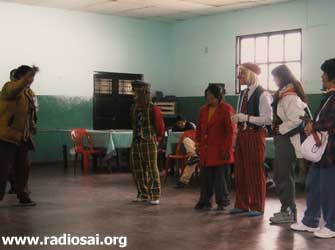 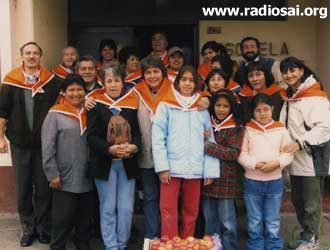 Sai service in psychiatry clinic in the province of Jujy Raising Up a Poor Community Gonzalez Catan is a small community about 40 kilometers from Buenos Aires. It was built by squatters on low-lying land, which floods during the yearly rainy season when the river overflows. Many petitions were signed by the residents of Gonzalez Catan, asking government authorities to resolve this problem, but with no help forthcoming their situation remained dire and their homes faced regular flooding. Then someone told them that Sai Baba could help. Not knowing who Sai Baba was, they imagined He was someone who lived in Buenos Aires. So, early one morning, the leader of the residents’ committee took the bus to the big city. He didn’t have any idea where to go, but his faith told him if he could find this Sai Baba, He would help them. He started by asking everyone he met if they knew where Sai Baba lived, assuming Him to be a well-known industrialist or politician. However, no one could give him a lead, and he searched for the better part of the day until he was so discouraged and tired that he was ready to give up. Sai service in psychiatry clinic in the province of Jujy Raising Up a Poor Community Gonzalez Catan is a small community about 40 kilometers from Buenos Aires. It was built by squatters on low-lying land, which floods during the yearly rainy season when the river overflows. Many petitions were signed by the residents of Gonzalez Catan, asking government authorities to resolve this problem, but with no help forthcoming their situation remained dire and their homes faced regular flooding. Then someone told them that Sai Baba could help. Not knowing who Sai Baba was, they imagined He was someone who lived in Buenos Aires. So, early one morning, the leader of the residents’ committee took the bus to the big city. He didn’t have any idea where to go, but his faith told him if he could find this Sai Baba, He would help them. He started by asking everyone he met if they knew where Sai Baba lived, assuming Him to be a well-known industrialist or politician. However, no one could give him a lead, and he searched for the better part of the day until he was so discouraged and tired that he was ready to give up. 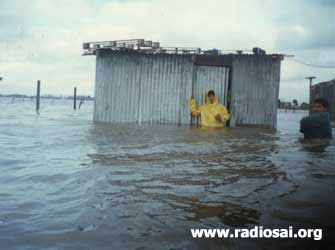 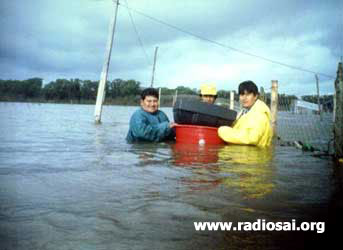 A sorry situation in Gonzalez Catan Salvaging some items Then he saw a drunken man lying in the street. He thought, “I will not ask this fellow because what can a drunk know?” But he reconsidered and asked the man, who pointed to a house across the street. It so happened that the Sai Organization Youth Coordinator for Buenos Aires lived there and he was at home. He listened to the tale of woe told by the Gonzalez Catan community representative. The Youth Coordinator promised he would visit the community with a group from the service wing to see what they could do. Serving the Gonzales Catan community A sorry situation in Gonzalez Catan Salvaging some items Then he saw a drunken man lying in the street. He thought, “I will not ask this fellow because what can a drunk know?” But he reconsidered and asked the man, who pointed to a house across the street. It so happened that the Sai Organization Youth Coordinator for Buenos Aires lived there and he was at home. He listened to the tale of woe told by the Gonzalez Catan community representative. The Youth Coordinator promised he would visit the community with a group from the service wing to see what they could do. Serving the Gonzales Catan community 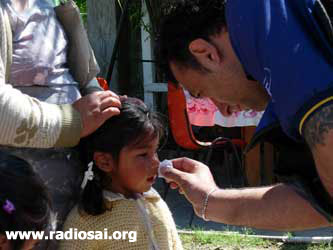 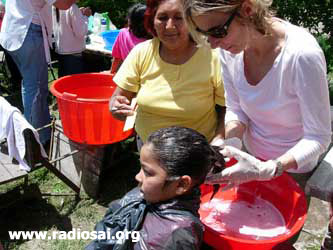 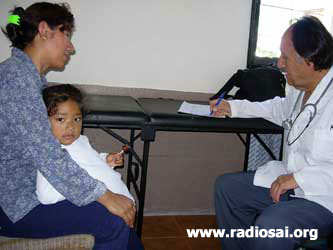 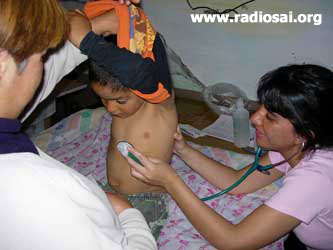 After assessing the conditions at Gonzalez Catan, the devotees ordered truckloads of earth and helped the community to elevate the level of their homes by 40 centimeters. Since the floors were raised two years ago, no water has entered their humble dwellings. The Sai Organization has also held medical camps there and visits weekly with food for the children and classes in human values. In February 2002, 480 patients were examined and provided free medicine by 100 Sai volunteers. In February 2006, an eye camp was held and free eyeglasses were offered. More service at Gonzales Catan After assessing the conditions at Gonzalez Catan, the devotees ordered truckloads of earth and helped the community to elevate the level of their homes by 40 centimeters. Since the floors were raised two years ago, no water has entered their humble dwellings. The Sai Organization has also held medical camps there and visits weekly with food for the children and classes in human values. In February 2002, 480 patients were examined and provided free medicine by 100 Sai volunteers. In February 2006, an eye camp was held and free eyeglasses were offered. More service at Gonzales Catan 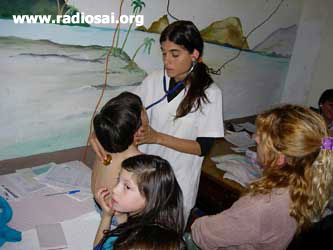 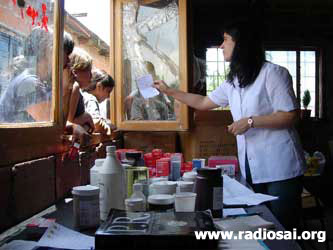 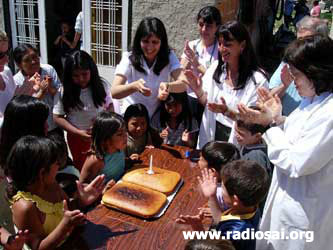 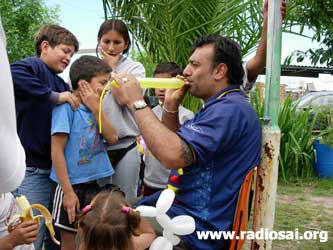 The flooding problem in Gonzalez Catan still exists, because the yearly overflow from the river is the primary cause. The devotees are currently looking for a more permanent solution, which may mean moving the community to higher and drier ground. Sai Canteens and Medical Service There are now fifteen Sai Canteens in operation, thanks to support from the Sai Foundation and individual Centers. The canteens serve lunch to neighborhood children, and, in some places, human values classes are taught by the Sai Youth wing. At one canteen in Córdoba, a vegetable garden is maintained by the devotees. The medical service wing was initiated by Dr. Jorge Berra and his wife Rosana, who organized large medical camps with over 100 devotees and up to 40 doctors participating They have taken these camps all over the countr,y and Dr. Berra has since been named Latin American Coordinator for Sai Medicare to develop this service across the continent. He is also a member of the Prasanthi Medical Council and works in the General Hospital in Puttaparthy when he visits Prasanthi Nilayam. The flooding problem in Gonzalez Catan still exists, because the yearly overflow from the river is the primary cause. The devotees are currently looking for a more permanent solution, which may mean moving the community to higher and drier ground. Sai Canteens and Medical Service There are now fifteen Sai Canteens in operation, thanks to support from the Sai Foundation and individual Centers. The canteens serve lunch to neighborhood children, and, in some places, human values classes are taught by the Sai Youth wing. At one canteen in Córdoba, a vegetable garden is maintained by the devotees. The medical service wing was initiated by Dr. Jorge Berra and his wife Rosana, who organized large medical camps with over 100 devotees and up to 40 doctors participating They have taken these camps all over the countr,y and Dr. Berra has since been named Latin American Coordinator for Sai Medicare to develop this service across the continent. He is also a member of the Prasanthi Medical Council and works in the General Hospital in Puttaparthy when he visits Prasanthi Nilayam. 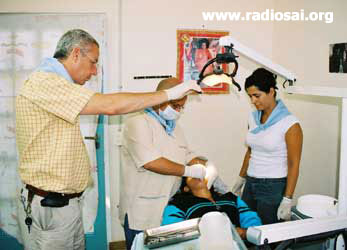 Dental work at Florencia Varela Dental work at Florencia Varela  Reaching out to the Underprivileged at Noccan Kani Noccan Kani is in Santa Fe province. The devotees have been helping the Toba community in this region. Doctors have taken measures to prevent and combat local diseases. The Sai Center of Santa Fe has organized workshops and taught knitting and sewing to 130 mothers in the community. These ladies now sew clothing for their families, make bedspreads, tablecloths, and school bags for their children, all from scrap materials obtained from a nearby industry. Devotees are providing literacy training for local mothers based on Sathya Sai Education in Human Values. They have purchased a small bus to travel back and forth and have constructed a community center with the involvement of the local residents. During the medical camp, they also vaccinated dogs to prevent epidemics. Children`s Camp At Noccan Kani In a medical camp held in 2003, twenty-seven medical professionals participated, serving more than 500 patients and providing free medicine. Medical camps in Argentina, as stated, are a continuous activity. In Grand Bourg, Buenos Aires, two camps were held in March 2006. One focused on eye care while the other was an all-specialty camp. Gran Rex and other Public Meetings In addition to EHV programs, medical service and other spiritual activities, in 2004 the Sai movement in Latin America instituted Sai Public Meetings, prompted by Baba Himself. This is a unique service activity heralding a new phase of Swami’s mission. The Sai Public Meeting at Gran Rex Theatre in May 2004 Reaching out to the Underprivileged at Noccan Kani Noccan Kani is in Santa Fe province. The devotees have been helping the Toba community in this region. Doctors have taken measures to prevent and combat local diseases. The Sai Center of Santa Fe has organized workshops and taught knitting and sewing to 130 mothers in the community. These ladies now sew clothing for their families, make bedspreads, tablecloths, and school bags for their children, all from scrap materials obtained from a nearby industry. Devotees are providing literacy training for local mothers based on Sathya Sai Education in Human Values. They have purchased a small bus to travel back and forth and have constructed a community center with the involvement of the local residents. During the medical camp, they also vaccinated dogs to prevent epidemics. Children`s Camp At Noccan Kani In a medical camp held in 2003, twenty-seven medical professionals participated, serving more than 500 patients and providing free medicine. Medical camps in Argentina, as stated, are a continuous activity. In Grand Bourg, Buenos Aires, two camps were held in March 2006. One focused on eye care while the other was an all-specialty camp. Gran Rex and other Public Meetings In addition to EHV programs, medical service and other spiritual activities, in 2004 the Sai movement in Latin America instituted Sai Public Meetings, prompted by Baba Himself. This is a unique service activity heralding a new phase of Swami’s mission. The Sai Public Meeting at Gran Rex Theatre in May 2004  The crowded hall at the Sai Public Meeting The crowded hall at the Sai Public Meeting 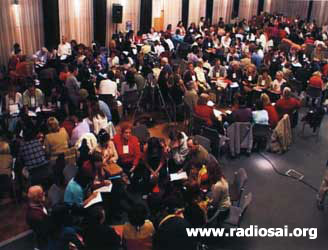 Small discussion groups after the main session Small discussion groups after the main session 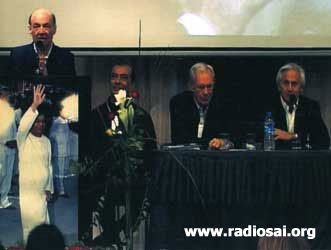 Dr. Michael Goldstein gives his talk Dr. Michael Goldstein gives his talk 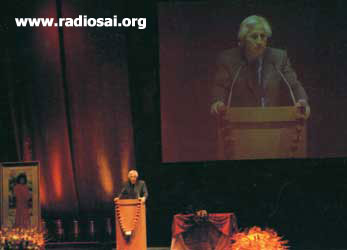 Mr. Leonardo Gutter addressing the Meeting On May 8-9 2004, a Public Meeting and Conference for Devotees was held in Buenos Aires, planned by Baba himself. Two hours before the doors opened, a line two blocks long surrounded the Gran Rex Theater, where the meeting was held. The 3200 capacity theater was filled with devotees as well as non-devotees. While people were being accommodated and lovingly welcomed by more than 100 volunteers, devotees sang_bhajans_ in Spanish on the stage for an hour. A high-quality photographic exhibition displaying seva (selfless service) activities in Argentina and Latin America aroused public interest. During the speeches given by Dr. Michael Goldstein and Mr. Leonardo Gutter, there was silence and serenity. When the movie His Work was shown, hundreds of eyes overflowed. After the meeting concluded, people did not want to leave and stayed in the theater lobby for more than forty-five minutes. The Ambassadors of Chile, Ukraine, Croatia, and Vietnam and notables from public and private institutions attended the meeting. The next day, 500 devotees from all over Latin America participated in workshops and listened to inspiring talks given by various office bearers. Many countries presented PowerPoint shows of their seva activities. The impact of the Public Meeting was beyond the imagination of the organizers. Argentina has also been fortunate to have many senior devotees of Bhagavan visit the country and share their experiences. Prof. Anil Kumar and Dr. Pavan recently visited Argentina. Both of these long-time devotees of Bhagavan reported that, “the enthusiasm shown by devotees to listen about Bhagavan and learn from His teachings was overwhelming.” Senior Devotees Share Swami's Love Mr. Leonardo Gutter addressing the Meeting On May 8-9 2004, a Public Meeting and Conference for Devotees was held in Buenos Aires, planned by Baba himself. Two hours before the doors opened, a line two blocks long surrounded the Gran Rex Theater, where the meeting was held. The 3200 capacity theater was filled with devotees as well as non-devotees. While people were being accommodated and lovingly welcomed by more than 100 volunteers, devotees sang_bhajans_ in Spanish on the stage for an hour. A high-quality photographic exhibition displaying seva (selfless service) activities in Argentina and Latin America aroused public interest. During the speeches given by Dr. Michael Goldstein and Mr. Leonardo Gutter, there was silence and serenity. When the movie His Work was shown, hundreds of eyes overflowed. After the meeting concluded, people did not want to leave and stayed in the theater lobby for more than forty-five minutes. The Ambassadors of Chile, Ukraine, Croatia, and Vietnam and notables from public and private institutions attended the meeting. The next day, 500 devotees from all over Latin America participated in workshops and listened to inspiring talks given by various office bearers. Many countries presented PowerPoint shows of their seva activities. The impact of the Public Meeting was beyond the imagination of the organizers. Argentina has also been fortunate to have many senior devotees of Bhagavan visit the country and share their experiences. Prof. Anil Kumar and Dr. Pavan recently visited Argentina. Both of these long-time devotees of Bhagavan reported that, “the enthusiasm shown by devotees to listen about Bhagavan and learn from His teachings was overwhelming.” Senior Devotees Share Swami's Love 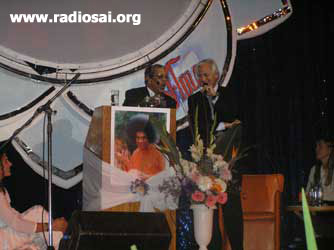 Prof. Anil Kumar enlightening the audience with Swami's teachings Prof. Anil Kumar enlightening the audience with Swami's teachings 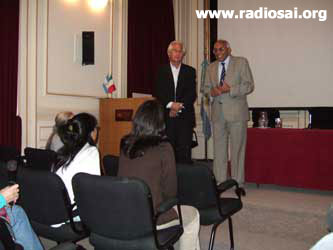 Dr. Sara Pavan Answers Questions If the Sai Organization has become a vibrant force in Argentina, it is because someone half a world away is pulling the strings. How Swami draws people to Him and then raises them to spiritual heights is an inspiring tale. The Argentinean devotees have had many divine experiences, but we would like to conclude with one classic tale. Carlos Fazzari – Cancer Canceled In 1984, Carlos Fazzari, from Pina Mar, a resort on the Atlantic Ocean 600 miles south of Buenos Aires, was diagnosed with an incurable disease. He prayed for his health and questioned why he had to die so young. In August 1992, he traveled to Miami just in time to get caught up in the disaster of Hurricane Andrew. After stocking up on food and emergency supplies, he took shelter in the home of a friend. Carlos thought to take a book to read while they waited out the storm. It was Howard Murphet’s, Sai Baba – Man of Miracles. The hurricane came ashore with a vengeance and destroyed all the homes in the area except the one Carlos had taken shelter in. Amazingly, the house survived without any signs of damage. After the storm, Carlos underwent another series of medical exams, and the results were worse than before. The doctors gave him six months to live. He returned to Buenos Aires and went to the Sai Center in Uriarte to buy more books on Sai Baba, hoping he might yet find a solution to his health crisis. At the Sai Center, he met Leonardo Gutter, an old friend he had not seen since they were boys. Leonardo encouraged Carlos to participate in seva activities at the Children’s Hospital. Three years later, he was able to travel to India to see Swami. In an interview, Baba told Carlos he should not worry and that He would cure him. Baba also gave him special vibhuti before he left. Eighteen years have passed since the original diagnosis of the terminal disease, and Carlos and his wife have come every year to stay with their beloved Baba for months at a time. Carlos came to understand that it was not only the physical disease that Swami treated but the disease of ignorance, which is even more important to be cured of. This was sufficient reason for his life extension. In 1996, after their return from India, Carlos and his wife started a Sai Center in Pina Mar, for which Baba gave them one of His robes. Dr. Sara Pavan Answers Questions If the Sai Organization has become a vibrant force in Argentina, it is because someone half a world away is pulling the strings. How Swami draws people to Him and then raises them to spiritual heights is an inspiring tale. The Argentinean devotees have had many divine experiences, but we would like to conclude with one classic tale. Carlos Fazzari – Cancer Canceled In 1984, Carlos Fazzari, from Pina Mar, a resort on the Atlantic Ocean 600 miles south of Buenos Aires, was diagnosed with an incurable disease. He prayed for his health and questioned why he had to die so young. In August 1992, he traveled to Miami just in time to get caught up in the disaster of Hurricane Andrew. After stocking up on food and emergency supplies, he took shelter in the home of a friend. Carlos thought to take a book to read while they waited out the storm. It was Howard Murphet’s, Sai Baba – Man of Miracles. The hurricane came ashore with a vengeance and destroyed all the homes in the area except the one Carlos had taken shelter in. Amazingly, the house survived without any signs of damage. After the storm, Carlos underwent another series of medical exams, and the results were worse than before. The doctors gave him six months to live. He returned to Buenos Aires and went to the Sai Center in Uriarte to buy more books on Sai Baba, hoping he might yet find a solution to his health crisis. At the Sai Center, he met Leonardo Gutter, an old friend he had not seen since they were boys. Leonardo encouraged Carlos to participate in seva activities at the Children’s Hospital. Three years later, he was able to travel to India to see Swami. In an interview, Baba told Carlos he should not worry and that He would cure him. Baba also gave him special vibhuti before he left. Eighteen years have passed since the original diagnosis of the terminal disease, and Carlos and his wife have come every year to stay with their beloved Baba for months at a time. Carlos came to understand that it was not only the physical disease that Swami treated but the disease of ignorance, which is even more important to be cured of. This was sufficient reason for his life extension. In 1996, after their return from India, Carlos and his wife started a Sai Center in Pina Mar, for which Baba gave them one of His robes. 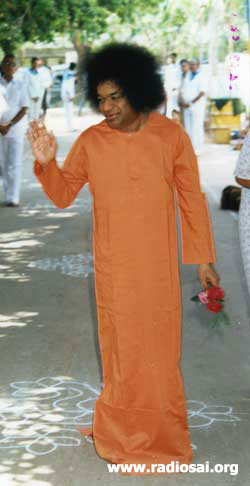 Sai’s All-embracing Love Sweeping Argentina ... The Sai movement in Latin America is going through an amazing period of rapid expansion and shows no signs of slowing down. It is truly phenomenal what is happening throughout the continent, and one can only watch in awe as Sai’s love moves from city to town and country to country. While the activities of the devotees — be they medical camps, public meetings, or EHV programs — are bringing Swami’s grace to thousands and purifying the hearts of those doing seva, the force behind this movement is, as always, the sankalpa (will) of the Avatar, which is unfolding simultaneously all over the planet. Swami once made a fist and said, “With this hand I do my work,” and then made a fist with the other hand and continued, “and these are my devotees.” There can be no better work on this earth than to offer one’s talent and skill, heart, and mind at the service of the Avatar. Sai’s All-embracing Love Sweeping Argentina ... The Sai movement in Latin America is going through an amazing period of rapid expansion and shows no signs of slowing down. It is truly phenomenal what is happening throughout the continent, and one can only watch in awe as Sai’s love moves from city to town and country to country. While the activities of the devotees — be they medical camps, public meetings, or EHV programs — are bringing Swami’s grace to thousands and purifying the hearts of those doing seva, the force behind this movement is, as always, the sankalpa (will) of the Avatar, which is unfolding simultaneously all over the planet. Swami once made a fist and said, “With this hand I do my work,” and then made a fist with the other hand and continued, “and these are my devotees.” There can be no better work on this earth than to offer one’s talent and skill, heart, and mind at the service of the Avatar.  |